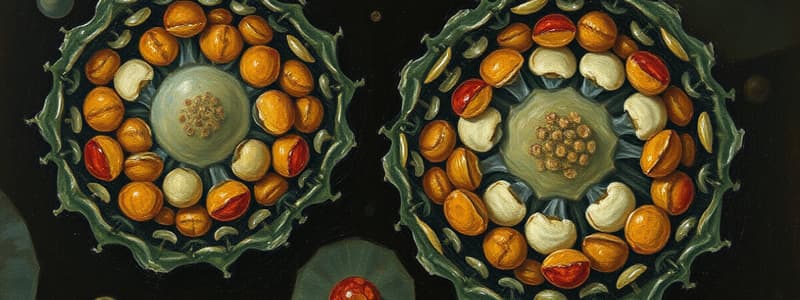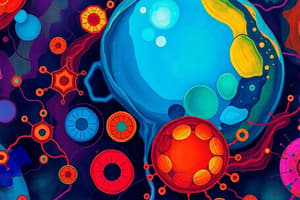Podcast
Questions and Answers
What distinguishes prokaryotic cells from eukaryotic cells in terms of cellular structure?
What distinguishes prokaryotic cells from eukaryotic cells in terms of cellular structure?
Prokaryotic cells lack a nucleus and membrane-bound organelles, while eukaryotic cells contain a nucleus and various organelles.
Explain the role of the mitochondria in cellular function.
Explain the role of the mitochondria in cellular function.
Mitochondria are the powerhouses of the cell, responsible for ATP production through cellular respiration.
What is the significance of the Golgi apparatus in eukaryotic cells?
What is the significance of the Golgi apparatus in eukaryotic cells?
The Golgi apparatus modifies, sorts, and packages proteins and lipids for secretion or use within the cell.
Describe the stages of mitosis and their importance in cell division.
Describe the stages of mitosis and their importance in cell division.
How do cells communicate with one another, and what is the role of receptors in this process?
How do cells communicate with one another, and what is the role of receptors in this process?
What is the primary distinction between anabolism and catabolism within metabolism?
What is the primary distinction between anabolism and catabolism within metabolism?
Explain how passive transport differs from active transport in terms of energy usage.
Explain how passive transport differs from active transport in terms of energy usage.
What role do cyclins and cyclin-dependent kinases play in the cell cycle?
What role do cyclins and cyclin-dependent kinases play in the cell cycle?
Discuss the significance of stem cells in cellular differentiation.
Discuss the significance of stem cells in cellular differentiation.
How does dysregulation of cell cycle control mechanisms contribute to cancer?
How does dysregulation of cell cycle control mechanisms contribute to cancer?
Flashcards are hidden until you start studying
Study Notes
Cell Biology
-
Cell Theory
- All living organisms are composed of one or more cells.
- The cell is the basic unit of life.
- All cells arise from pre-existing cells.
-
Types of Cells
- Prokaryotic Cells
- Lack a nucleus and membrane-bound organelles.
- Generally smaller and simpler (e.g., bacteria).
- Eukaryotic Cells
- Contain a nucleus and membrane-bound organelles.
- Larger and more complex (e.g., plant and animal cells).
- Prokaryotic Cells
-
Cell Structure
- Cell Membrane
- Phospholipid bilayer that regulates what enters and exits the cell.
- Contains proteins, cholesterol, and carbohydrates.
- Cytoplasm
- Gel-like substance inside the cell, where organelles are located.
- Nucleus
- Contains genetic material (DNA).
- Controls cellular activities and reproduction.
- Organelles
- Mitochondria: Powerhouse of the cell, site of ATP (energy) production.
- Ribosomes: Sites of protein synthesis.
- Endoplasmic Reticulum (ER):
- Rough ER: Studded with ribosomes, involved in protein synthesis.
- Smooth ER: Lacks ribosomes, involved in lipid synthesis and detoxification.
- Golgi Apparatus: Modifies, sorts, and packages proteins and lipids for secretion or use within the cell.
- Lysosomes: Contain enzymes for digestion of cellular waste and macromolecules.
- Chloroplasts (in plant cells): Site of photosynthesis, contain chlorophyll.
- Cell Membrane
-
Cell Division
- Mitosis: Process of cell division that results in two identical daughter cells; involved in growth and repair.
- Stages: Prophase, Metaphase, Anaphase, Telophase.
- Meiosis: Specialized form of cell division that produces gametes (sex cells).
- Results in four genetically diverse cells; crucial for sexual reproduction.
- Mitosis: Process of cell division that results in two identical daughter cells; involved in growth and repair.
-
Cell Communication
- Cells communicate through chemical signals (hormones, neurotransmitters).
- Receptors on cell membranes receive signals and trigger responses (signal transduction).
-
Metabolism
- Anabolism: Building up of molecules (e.g., synthesis of proteins).
- Catabolism: Breaking down of molecules (e.g., cellular respiration).
-
Transport Mechanisms
- Passive Transport: Movement of substances across a cell membrane without energy (e.g., diffusion, osmosis).
- Active Transport: Movement of substances against a concentration gradient; requires energy (e.g., sodium-potassium pump).
-
Cell Specialization
- Cells differentiate to perform specific functions (e.g., muscle cells, nerve cells).
- Stem cells retain the ability to differentiate into various cell types.
-
Cell Cycle Regulation
- Controlled by proteins called cyclins and cyclin-dependent kinases (CDKs).
- Checkpoints ensure proper division and function; dysregulation can lead to cancer.
Cell Theory
- All organisms are made of one or more cells, the basic unit of life.
- New cells originate from existing cells through cell division.
Types of Cells
-
Prokaryotic Cells
- Do not contain a nucleus or membrane-bound organelles.
- Smaller and simpler in structure, commonly represented by bacteria.
-
Eukaryotic Cells
- Possess a nucleus and various membrane-bound organelles.
- Larger and more complex, include plant and animal cells.
Cell Structure
-
Cell Membrane
- Composed of a phospholipid bilayer that monitors the entry and exit of substances.
- Contains proteins, cholesterol, and carbohydrates for functionality.
-
Cytoplasm
- Gel-like medium within the cell housing the organelles.
-
Nucleus
- Houses genetic material in the form of DNA.
- Regulates cellular activities and reproduction.
-
Organelles
- Mitochondria: Known as the powerhouse of the cell; primary site for ATP production.
- Ribosomes: Responsible for protein synthesis.
- Endoplasmic Reticulum (ER):
- Rough ER has ribosomes on its surface, plays a role in protein synthesis.
- Smooth ER lacks ribosomes, involved in lipid synthesis and detoxification.
- Golgi Apparatus: Modifies, sorts, and packages proteins and lipids for further use or secretion.
- Lysosomes: Contain enzymes to digest waste materials and cellular debris.
- Chloroplasts (located in plant cells): Sites for photosynthesis, containing chlorophyll for capturing light energy.
Cell Division
-
Mitosis
- Leads to two genetically identical daughter cells; essential for growth and repair.
- Includes stages: Prophase, Metaphase, Anaphase, Telophase.
-
Meiosis
- Special type of cell division producing gametes (sex cells).
- Results in four genetically diverse cells; vital for sexual reproduction.
Cell Communication
- Cells utilize chemical signals, including hormones and neurotransmitters, to communicate.
- Cell membrane receptors detect these signals, initiating internal responses via signal transduction pathways.
Metabolism
-
Anabolism
- The synthesis of complex molecules from simpler ones, such as protein formation.
-
Catabolism
- The breakdown of complex molecules into simpler ones, exemplified by cellular respiration.
Transport Mechanisms
-
Passive Transport
- Involves the movement of substances across cell membranes without requiring energy, examples include diffusion and osmosis.
-
Active Transport
- Requires energy to move substances against their concentration gradient (e.g., sodium-potassium pump).
Cell Specialization
- Cells differentiate to perform distinct functions, e.g., muscle and nerve cells.
- Stem cells have the capability to evolve into various cell types.
Cell Cycle Regulation
- Controlled by cyclins and cyclin-dependent kinases (CDKs).
- Checkpoints monitor the cell cycle for errors; dysregulation may result in cancer development.
Studying That Suits You
Use AI to generate personalized quizzes and flashcards to suit your learning preferences.





